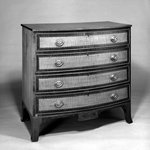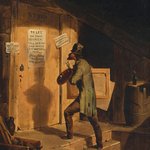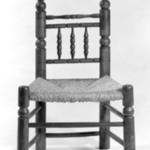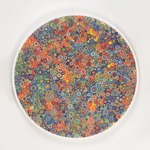Center Table
Decorative Arts and Design
This center table was made by Baltimore’s preeminent cabinetmaker, John Finlay. Baltimore furniture makers developed a unique interpretation of the Neoclassical style characterized by bold forms and painted and stenciled decoration. The top was made in Italy, although its painted scene is based on the work of the Vernet family of France. The technique used to make the top, called scagliola (Italian for “plaster”), is a less expensive and less labor-intensive alternative to the traditional technique of hardstone mosaic.
MEDIUM
Wood, brass, gilt, plaster (scagliola)
DATES
ca. 1825
DIMENSIONS
30 3/8 x 33 x 33 in. (77.2 x 83.8 x 83.8 cm)
(show scale)
MARKINGS
Underside of table inscribed, "Maritime Vernet", which probably refers to either Claude Joseph Vernet or Carle Vernet; both were French artists known for their maritime-inspired engravings.
ACCESSION NUMBER
88.24
CREDIT LINE
Purchased with funds given by an anonymous donor, gift of the American Art Council and Designated Purchase Fund
CATALOGUE DESCRIPTION
Center table, wood, brass, and scagliola. Table is ebonized and embellished with simulated rosewood graining (pedestal), stenciled and free hand gilt work, applied brass roundels and a decorated scagliola circular top. Top is supported by a turned wooden pedestal, which is raised by four down swept C-scrolled legs, which terminate with brass animal paw toe tips. Pedestal and legs are ebonized and decorated with gilt anthemion, gilt borders and round brass medallions. The convex apron of the table (5 3/4"high) is constructed of narrow strips of wood, stacked five layers high, and ebonized with gilt borders and a gilt rinceaux design repeated five times. The circular scagliola top has a painting comprising three men fishing and a basket-bearing female, all placed in a seaside landscape. In the far left horizon is a medieval castle, and an enclosing fortezza, and adrift of the shore is a full-mast ship. Surrounding border consists of tromp l'oeil beads, shaded in gold monochromatic hues. Succeeding the beaded border is a narrow circular border, which is rose in color. The outermost border is a continuous circle of intertwined oak leaves and acorns, shaded in monochrome tones of brown. Background of tabletop is black.
CONDITION: Fair; several deep and penetrating cracks in top (top previously broken and repaired, re-backed), various water stain "rings". Stacked wood layers of apron are buckling. Various chips in ebonized surface. Gilt work in excellent condition.
MUSEUM LOCATION
This item is not on view
CAPTION
Table legs attributed to John Finlay (American, born Ireland, 1777–1851). Center Table, ca. 1825. Wood, brass, gilt, plaster (scagliola), 30 3/8 x 33 x 33 in. (77.2 x 83.8 x 83.8 cm). Brooklyn Museum, Purchased with funds given by an anonymous donor, gift of the American Art Council and Designated Purchase Fund, 88.24. Creative Commons-BY (Photo: Brooklyn Museum, 88.24_top_bw.jpg)
IMAGE
top, 88.24_top_bw.jpg. Brooklyn Museum photograph
"CUR" at the beginning of an image file name means that the image was created by a curatorial staff member. These study images may be digital point-and-shoot photographs, when we don\'t yet have high-quality studio photography, or they may be scans of older negatives, slides, or photographic prints, providing historical documentation of the object.
RIGHTS STATEMENT
Creative Commons-BY
You may download and use Brooklyn Museum images of this three-dimensional work in accordance with a
Creative Commons license. Fair use, as understood under the United States Copyright Act, may also apply.
Please include caption information from this page and credit the Brooklyn Museum. If you need a high resolution file, please fill out our online
application form (charges apply).
For further information about copyright, we recommend resources at the
United States Library of Congress,
Cornell University,
Copyright and Cultural Institutions: Guidelines for U.S. Libraries, Archives, and Museums, and
Copyright Watch.
For more information about the Museum's rights project, including how rights types are assigned, please see our
blog posts on copyright.
If you have any information regarding this work and rights to it, please contact
copyright@brooklynmuseum.org.
RECORD COMPLETENESS
Not every record you will find here is complete. More information is available for some works than for others, and some entries have been updated more recently. Records are frequently reviewed and revised, and
we welcome any additional information you might have.
Is this painted or inlaid?

This table top was made using a technique called 'scagliola', which is a type of plaster mixed with glue and dyed to resemble mosaic work. This technique was first developed in ancient Rome but experienced a revival in the 18th and 19th centuries, and was used often to imitate marble.
Please give us information regarding this table.

The base of this table was created by one of the premier furniture-making firms in Nineteenth-century Baltimore, that of John and Hugh Finlay. The decorative top is attributed to the Della Valle brothers who worked in Livorno, Italy.
Italians, of course. Thanks.
You're welcome! The Della Valle brothers were known for their mastery of a plastering technique called scagliola. Notice that this table top is flat and painted, but with a high degree of trompe l'oeil. It's especially noticeable in the beaded border of the painting, even the beads have shadows!











































